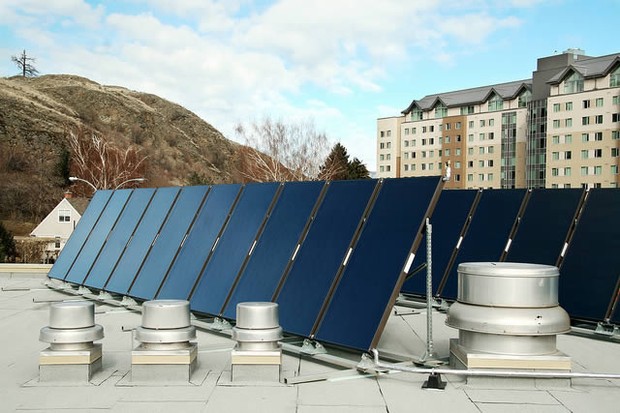A Millennial Middle America
By
Guest Blogger
Posted:
Solar panels at Thompson Rivers University/ Photo by Thompson Rivers, Creative Commons
By Tarsi Dunlop
Millennial America – the generation born between 1981 and 2000 – is bigger than the boomers and values innovation, government stewardship and community investment. That means the time is ripe for consumers and environmentalists to push for better clean energy technologies. In the Washington Post Matthew Stepp argued, “the best way to make clean energy ready for prime time is through public investments in innovation.” The Millennial vision for America is one of smart investment for a robust and sustainable future, and public investment for truly cutting-edge innovation is a risk worthy of the federal government. The United States is reluctant to lead and sign onto any international efforts to deal with climate change and time is running out. Domestically, we as citizens have an opportunity to push for smarter and more robust investments. If we are truly concerned about climate change, and 72 percent of us are according to a recent poll, then we should use our consumer power to push for better and more efficient alternatives.
As citizens we pay taxes, but federal government expenditures may not always line up with our own priorities. For example, in 2011, according to National Priorities Project data, 1.9 cents for every dollar paid in taxes went to Energy & Environment. This category covers all environmentally-related initiatives, but not expenditures related to nuclear weapons. My 2012 tax receipt says I spent approximately $95 on Energy & Environment, with $11.66 on energy conservation. However, Stepp makes the argument that even in these tight budgetary times, funding can be shifted. Stepp argues that money spent supporting high-cost clean technologies and giving tax breaks to mature fossil fuels could be invested in other research, testing, prototyping and development, perhaps particularly with solar and geothermal energy sources. If costs are truly one of the greatest challenges to adopting a greener lifestyle, more R&D investment to produce consumer friendly products may be the solution.
The challenge, particularly for a Millennial America that stands behind values of smart sustainable public investment, is how to efficiently and effectively lead this effort and write this narrative. Millennials of all ages are combining efforts, through organizations such as 350.org, Energy Action Coalition, and Power Shift, and showcasing their policy solutions through the annual Roosevelt Institute | Campus Network’s 10ideas journal for Energy & Environment, and the Blueprint for Millennial America. Competitions such as the U.S. Department of Energy’s Solar Decathlon or those hosted by the University of Michigan’s Energy Institute are encouraging youth to put forth their scientific innovations to promote sustainable development. It’s also noteworthy that houses built for the Decathlon are relatively affordable to construct.
As the world’s population continues to rise, we are facing an increasing strain on our resources. We need research and design investments to help us reduce human impact on natural resources – clear air and water, and land conservation. Addressing climate change is a moral imperative, but through strategic planning, there is a chance to compromise when it comes to footing the bill for moving to a more sustainable way of living. Government, as a steward of the common good, can invest in innovative research to help bring costs down so that Americans from all socioeconomic backgrounds can afford to be part of this effort.
Tarsi Dunlop is the former Director of Operations for the Roosevelt Institute Campus Network and the Communications Director for the Roosevelt Pipeline, DC Chapter.
